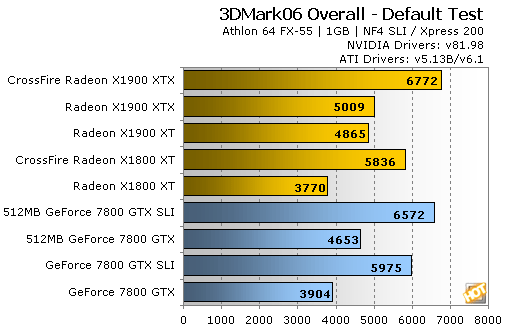ATI Radeon X1900 XTX And CrossFire: R580 Is Here
3DMark06 v1.0.2

|
| Futuremark recently launched a brand-new version of their popular benchmark, 3DMark06. The new version of the benchmark is updated in a number of ways, and now includes not only Shader Model 2.0 tests, but Shader Model 3.0 and HDR tests as well. Some of the assets from 3DMark05 have been re-used, but the scenes are now rendered with much more geometric detail and the shader complexity is vastly increased as well. Max shader length in 3DMark05 was 96 instructions, while 3DMark06 ups the number of instructions to 512. 3DMark06 also employs much more lighting, and there is extensive use of soft shadows. With 3DMark06, Futuremark has also updated how the final score is tabulated. In this latest version of the benchmark, SM 2.0 and HDR / SM3.0 tests are weighted and the CPU score is factored into the final tally as well. |

3DMark06's overall score has the X1800 XT falling prey to the 7800 GTX, but the Radeon X1900 XT, XTX, and CrossFire configuration best NVIDIA's competitive offerings by a few hundred points. We've also got the individual graphics scores, however, which tell a much more interesting story.

With 3DMark06's Shader Model 2.0 tests, which are basically updated versions of the "game" tests that were part of 3DMark05, a pair of 512MB 7800 GTX running in SLI mode finishes on top, followed by X1900 CrossFire. A single 512MB GTX trails the X1900, however, which hints to SLI's better scaling in this benchmark.

The new HDR/Shader Model 3.0 tests in 3DMark06 tell yet another story. Here, nothing touches the Radeon X1900, and the only edge NVIDIA has is a pair of GTXs over X1800 XT CrossFire, but even then the margin of victory is only 10 points. It seems that, at least according to 3DMark06, that Shader Model 2.0 performance should be competitive between NVIDIA and ATI, but that ATI should have an edge in Shader Model 3.0 performance. Let's see how things pan out in our actual "real-world" game tests.







